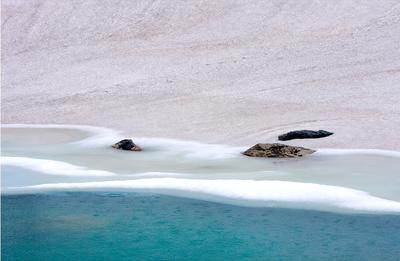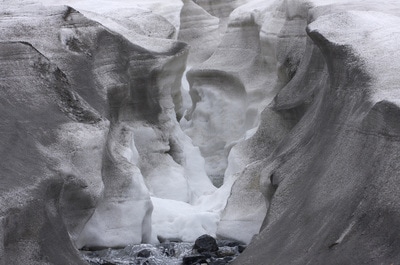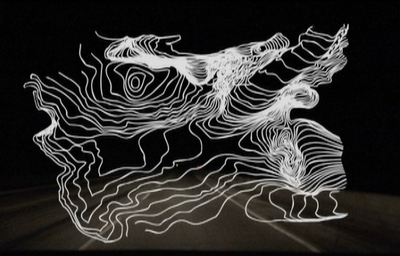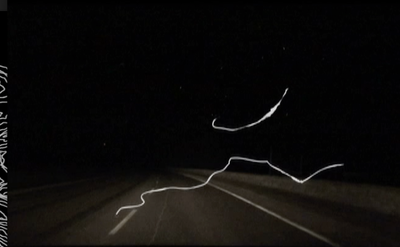Contours in the Crosshairs
 Athabasca Glacier, 2010. N.Nisbet.
Athabasca Glacier, 2010. N.Nisbet.
a
|
About the Project
Contours in the Crosshairs is an installation of video projection, broken glass sculpture, and still images. The video shows the slow motion passage of a mountain highway from the car driver’s perspective. Layered over the highway clip is another video that shows the gradual erasure of the contour lines of the Athabasca Glacier. The 20 min silent video is projected onto the frosted surface of a suspended car windshield. Over 2000 pounds of crumbled auto glass becomes a sculptural glacier, and adhered to the large gallery window is a massive transparent image of the Athabasca Glacier today. Rather than falling into the trap of oversimplifying the complexity of human activity and climate change, Contours in the Crosshairs attempts to address the fluctuating grays between a black and white critique of car culture, social responsibility and human impact on climate change. Contours in the Crosshairs is a poetic piece with impact. The view of the road is nostalgic, the passage of time is extended, and the disappearance of the contour lines is subtle. At any particular moment, viewers are unlikely to notice what is happening to the contour lines, but after a minute or so, the relentless erasure becomes seductively apparent. The aesthetically appealing pile of luminous glass attracts the viewers attention, its impact functions with the dawning awareness of the violence of the broken auto glass and its metaphoric representation of the disappearing glaciers. A minuscule representation of the massive environmental issues stemming from human activity. |
Glaciers and Climate ChangeGlaciers are disappearing at an alarming rate. One direct result of melting glaciers is a concurrent rise in sea level. By the end of this century it is anticipated that there will be a rise in sea level of between 4 and 9.5 inches that will result in shoreline retreats of 100 feet or more and directly endanger the estimated 100 million people currently living within 3 feet of sea level. The Columbia Icefield is located between Banff and Jasper National Parks. It is one of the largest accumulations of ice and snow south of the Arctic Circle covering nearly 325 square km. The rapid retreat of the Athabasca Glacier is the “single best accessible example in what we are seeing happening in the world because of climate change today,” says Bob Sandford, author of The Columbia Icefield. In a CBC news article by Jeff McIntosh of the Canadian Press, John Wilmshurst, conservation specialist, says the Athabasca Glacier could disappear within generation.
|
Columbia Icefields Parkway
"The Columbia Icefield is a surviving remnant of the thick ice mass that once mantled most of Western Canada's mountains. Lying on a wide, elevated plateau, it is the largest icefield in the Canadian Rockies". |
|
|













